Over time, every family has a lot of things that have become unusable. These include children's clothes with stains that won't wash out, old T-shirts that have served their purpose, and jeans. But many thrifty housewives have found a way to breathe new life into these rags. An increasingly popular method among them is knitting rugs crochet from the remains of threads, rags, weaving them from various cords and ribbons, making them using carpet technique on the base. Some methods of making such a household attribute are given below in the article.
Preparing the yarn
Crocheting rugs from rags requires preliminary preparation of yarn from them.
It consists of:
- Selecting old things based on the structure of the fabric that match each other.
- Cutting sorted raw materials into strips.
- Selection of ribbons by color (if necessary).
- Final preparation of yarn for knitting.
To correctly select the necessary material for making floor mats from rags, first of all it should be sorted and sorted by type of material. That is, knitted items should be put in one pile, denim in another, cotton in a third, synthetic in a fourth, and so on.
- After sorting the rags by fabric quality, it should be prepared for cutting. To do this, it is necessary to cut off all the seams, that is, along the bottom of the product and sleeves.
- Next, lay the item out on a hard surface and cut it into strips from one side seam to the parallel one, but not reaching it by 2-3 cm. This is necessary in order to create one continuous strip later.
- When performing this operation, you should know that it is recommended to cut thick fabric into narrow strips, and thin fabric into wider ones.
- After such a cut, in place of the continuous section of material, oblique cuts are made from one strip to the next, that is, the result should be a spiral-shaped continuous tape.
- If it breaks, it is advisable to sew the ends together by placing them on top of each other. Tying knots is not recommended. This will create inconvenience during further work and will spoil the appearance of the finished product.
- After cutting the tape from heavily fraying fabrics, before winding it into a ball, it is advisable to treat its cuts with fire. This technique will secure the cut threads and extend the life of the rug.
- The resulting yarn is wound into balls.
Simple round crochet rug
Crocheting rugs from round rags is not difficult at all if a person knows how to hold a hook in his hand and knows the techniques of making two loops - an air loop and a single crochet or just one single crochet.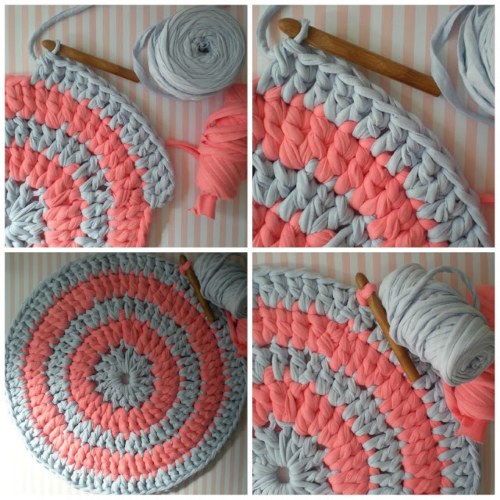
In order to avoid a hole in the center of the rug, experienced craftswomen recommend starting work with a ring of yarn formed by wrapping it twice around the index finger. With this method, after knitting the first row of loops, it is convenient to eliminate the gap in the ring by tightening the end of the yarn left from the wrapping. Then this remainder is hidden inside the knitted columns and cut off.
- After knitting the first row, it is closed by connecting the outermost column with the first, pulling the captured working thread under the two arcs of the initial loop through the loop on the hook.
- Next, to complete the second row, you need to knit 2 lifting chain stitches. This technique prevents the fabric from skewing and also maintains its flat shape.
- Then knit the second row with the same single crochet stitches. But to create the correct round, not dome-shaped, shape of the rug, you need to make 2 stitches in each subsequent loop of the previous row. Finish the row similarly to the first.
Each subsequent circular row is knitted similarly to the one below, but to maintain the flat shape of the rug, it is necessary to make increases. Their number and frequency are calculated individually. This depends on the number of loops in the first row, the thickness of the material used and the density of knitting. With the available experience and skills, the need for additional loops is determined visually.
After reaching the desired diameter of the product, the outer row is closed, secured and the end of the yarn is hidden inside the knitted loops.
Round braided rug
Another option for making a round rug is to combine crochet and sewing. This combined technique is used if the yarn is thick. It creates inconvenience in the process of circular knitting. Therefore, to make such a rug, first a very long chain of air loops is knitted from the prepared yarn. Then it is laid out evenly in a spiral, securing each subsequent turn with the previous one with a needle and thread. The result is a not too rough, but dense rug.
Floor rug made of round motifs
One of the interesting solutions for making floor mats is various combinations of round fragments. They can be made:
- made of the same material in structure, but differing in color range;
- from fabrics of varying composition and color;
- from several types of patterns.
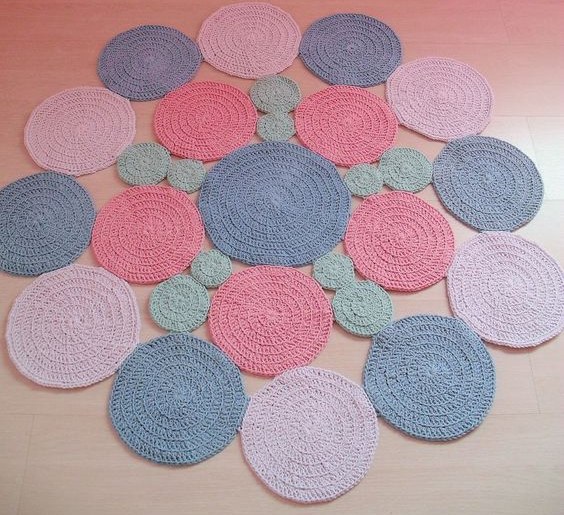

The connection of motifs can be done both when knitting the outer row of each fragment, and after they are completely knitted. This depends on whether there is a preliminary layout of the elements or it is made during the knitting process, how many and what sizes of parts are prepared.
Openwork rug
Knitting rugs with a crochet hook from rags using openwork hemstitches has become quite a popular phenomenon in the interior of many houses. This is due to the fact that the "gaps" formed between the rows can be decorated in a variety of ways. For example:
- Contrasting yarn or ribbon can be pulled through the vertical bands;
- used to introduce decorative details such as leaves, flowers, ruffles, etc. into a standard pattern;
- During knitting, you can insert a LED cord into some circular openwork rows. This will not only create coziness in the room, but will also become an original addition to the interior.
For openwork rugs, it is recommended to use thin and medium-thick yarn, since the finished product made from thick material will look awkward and rough.
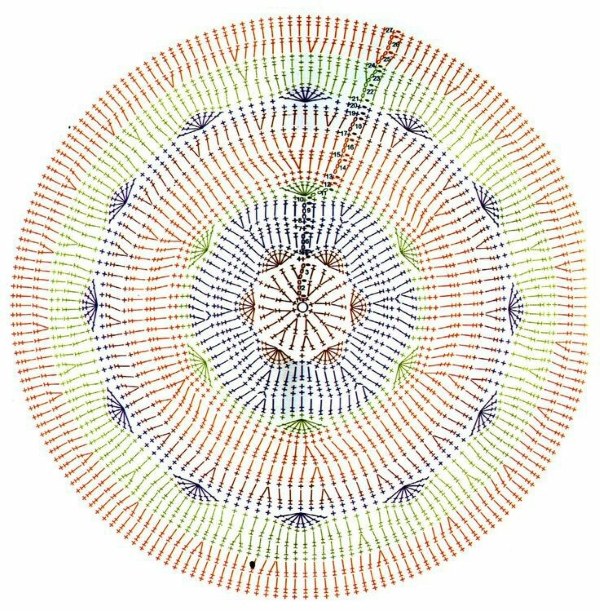
Any pattern, as well as a diagram for its implementation, can be used for floor rugs. A large variety of them can be found on the Internet. Round napkin patterns are also suitable for this. But too complex and ornate openwork should not be used.
Firstly, performing operations with a large number of loops will be difficult due to the thickness of the yarn.
Secondly, in places with a large number of posts or their combinations, compactions will be created, which will adversely affect the appearance of the finished product and will cause discomfort during direct use.
Below are some patterns for floor mats:
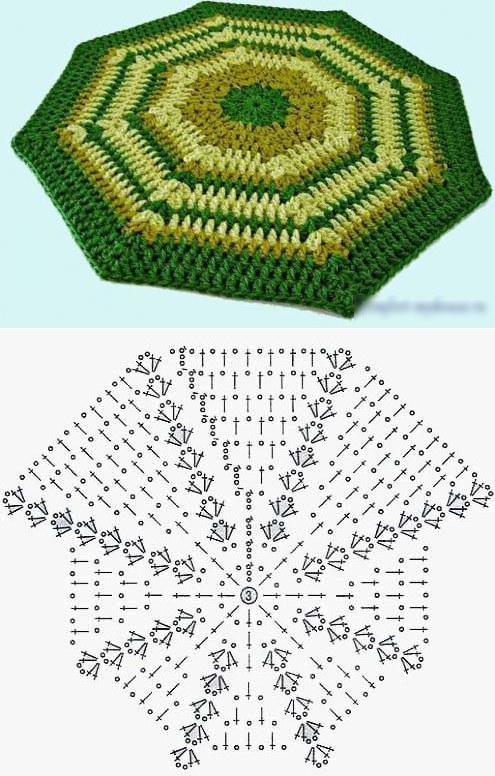
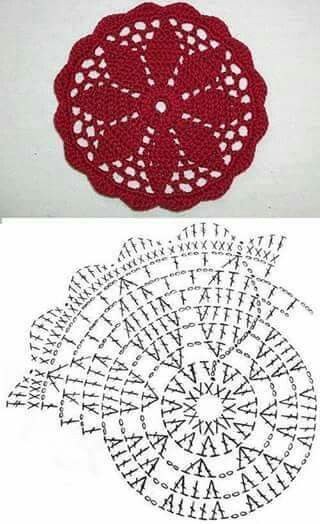
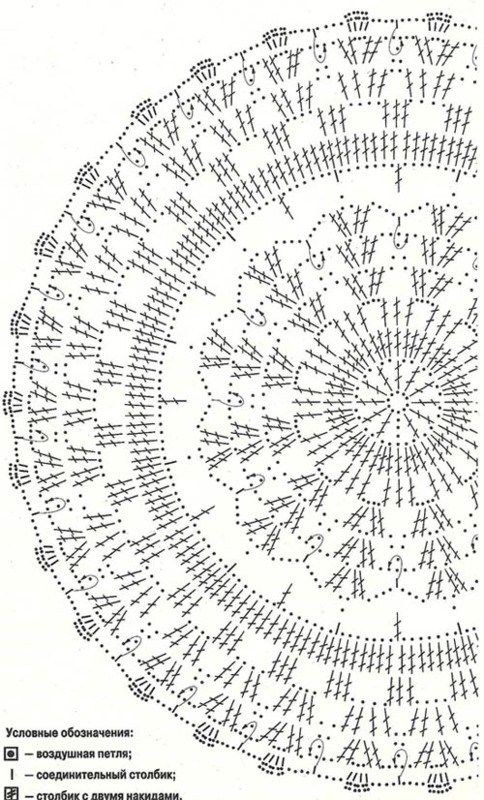
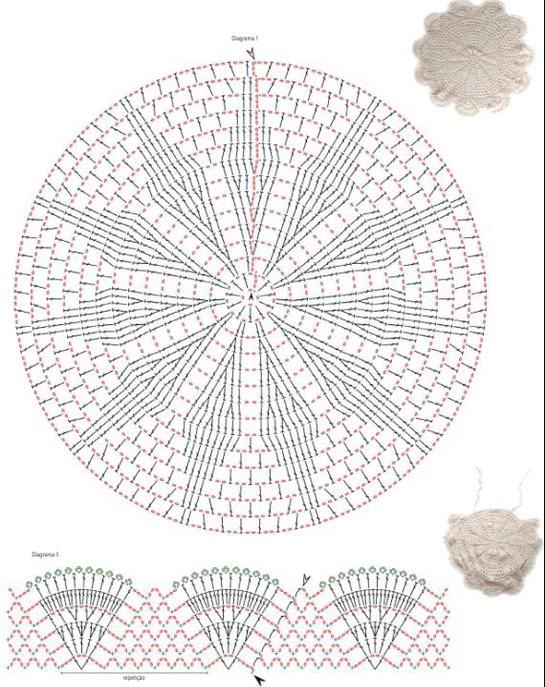
In the form of a scarf
Knitting rugs in the form of a scarf from rags with a crochet hook can be done in 2 versions:
- longitudinal,
- transverse.
The difference between these methods is that with longitudinal knitting, you must immediately set the desired length, since it will not be possible to increase it later. With transverse knitting, such a possibility exists. The same applies to the width of the product. In the longitudinal direction, it can be changed, but not in the transverse direction.
Since the production of rectangular rugs involves straight and reverse rows, it is recommended to choose double-sided patterns for them, that is, so that they look the same on the front and back sides.
If knitting is done in the most common way, with single crochets, then in order to avoid compaction between the rows, with each subsequent knitting, the working thread should be grabbed not under the two arcs of the lower loop, but only behind the back one. In this way, even horizontal or transverse stripes (depending on the direction of knitting) are formed on the front and back sides, created by the remaining front arcs.
Rectangular rugs made from square motifs
A beautiful floor rug can also be created using numerous multi-colored elements or fragments of the material used that differ in structure.
The knitting pattern can be either circular, straight or reverse. It depends on the thickness of the yarn used. For thinner source material, openwork patterns are acceptable. For dense raw materials, motifs from straight and reverse rows are better suited. The size of the fragments is determined individually and depends on the required parameters of the finished product.
The coupling of motifs can also be done in two ways: when knitting the outer row and after making a full set of parts. The connection of separately knitted motifs is done with a crochet hook or sewn with a needle and thread.
Pentagonal rug
A simple, but at the same time original solution is to make a pentagonal rug from an ordinary round rug. It is enough to make some calculations at the beginning of knitting. Before you start making the first row around the initial ring, you should decide on the required number of loops, a multiple of 5. Depending on the thickness of the yarn, there can be 10, 15, and so on.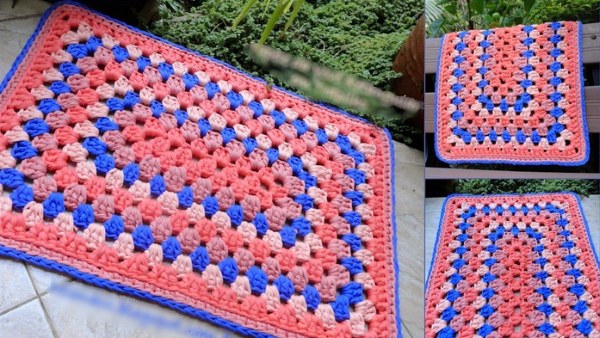
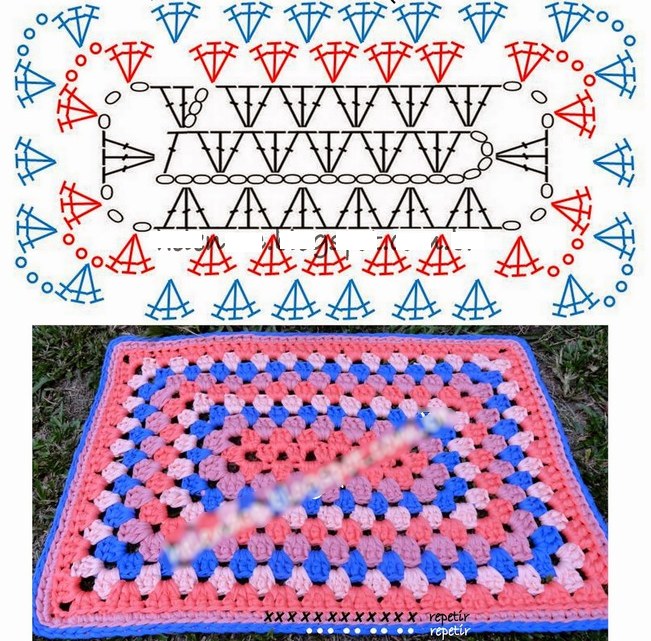
When knitting the second row, it is necessary to make tensions between the resulting five groups of loops from a certain number of air loops. Their length is determined individually, based on the thickness of the material used.
When performing each subsequent circular row, do not forget about the additional addition of loops in each first and last loop of a separate group. Their frequency is determined visually in order to avoid both the formation of a dome-shaped rug and the presence of folds.
After reaching the required diameter of the rug, the outer row is closed with a slip stitch, the loop is secured, and the end of the yarn is hidden in the previously knitted rows.
Based on
Knitting rugs with a crochet hook from rags can also be done on a base. The technique of making rugs in this way is called carpet. It consists of filling the cells of the base with pieces of yarn or strips of fabric. The result is a fluffy, soft rug with a pile of a certain length.
In order to knit such a rug, a special base is needed. Due to the multiple use of the finished product, it must be durable and wear-resistant, so stramin is used for such purposes. But due to its high cost and difficulty in acquiring, experienced craftswomen have found an excellent way out of this situation.
They suggest making the base for the rug yourself. This will require strong cotton threads. Next, depending on the shape of the intended rug, as well as the thickness of the material used, you should knit a grid with identical cells. This can be a fabric of regular alternation of single crochets and 1 air loop, or a column with 1 yarn over and 2 air loops.
In case of knitting round rugs, additional cells must be introduced into the mesh so that the base maintains a flat horizontal position. The size of the mesh base must be equal to the final parameters of the product.
After making the frame, it should be carefully treated with waterproof glue. At the same time, you need to ensure that all the cells inside are not covered with adhesive film. Then let the base dry and you can begin to directly make the rug.
It should be noted that a special hook is used for knitting carpet-weaving products. It is a slightly curved tool with a closing head and a thick wooden handle. This hook structure is necessary for the convenience of gripping the yarn or material under the warp and forming a fastening loop.
In addition to knitting the base for the rug, you should also prepare the yarn in advance. This process involves cutting identical pieces of leftover threads or strips of fabric. The length should not be less than 6-8 cm, since in addition to the pile, its consumption is used to make the fastening loop. There should be a lot of them, because one unit is used to close one cell of the base mesh.
The color scheme in this technique can be varied. When using multi-colored pieces of fabric, you will get a bright rug with an abstract pattern. If a clearer pattern or ornament is envisaged, then it is necessary to prepare material of the corresponding color scheme. To make a rug with a pattern, the preliminary preparation also includes a pattern scheme in cells for the convenience of its embodiment in reality.
To start working, take a hook and insert it under the first cell. Fold the prepared strip of fabric in half and grab the resulting loop with a hook. Pull it over the base, holding the ends. Pull the connected ends of the strip through the resulting loop. Pull the resulting pile with your hand, securing the loop on the base. Exactly the same operation should be done with each subsequent cell. For convenience, it is recommended to knit this way from right to left.
By filling one row of cells after another in this way, you get a solid, fluffy and very soft floor rug.
Made of denim
Since denim is quite dense and coarse, it is recommended to make strips of it for knitting floor rugs as thin as possible. But the problem is that this material is very loose. During cutting, as well as twisting into balls, its structure quickly collapses and the strength of the prepared yarn is lost. To avoid such troubles, after cutting denim products into strips, it is advisable to treat their cuts with fire. The threads sintered along the edges prevent the yarn from shedding for a long time and create more comfortable conditions for working with it.
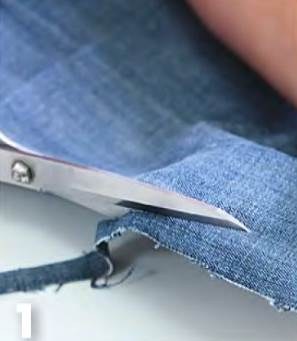



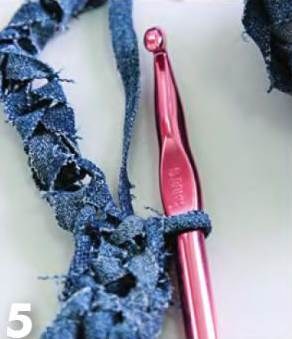



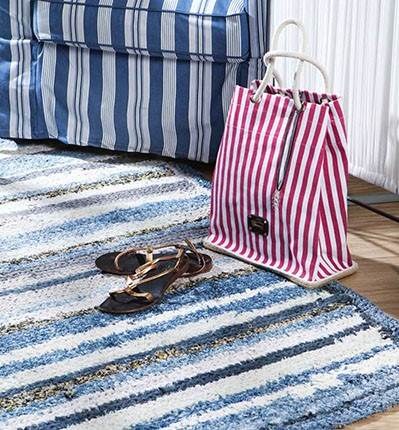
Due to its density, denim yarn is difficult to crochet. The best option for making a rug from this material would be a crocheted chain of air loops, which will then be collected into a spiral and secured layer by layer.
Made of knitted fabric
Knitted fabric products are the most common and high-quality material for making knitted floor rugs. It can be cut into strips of any width. The resulting yarn is soft, elastic, and durable. It does not crumble, but, when stretched, creates an even, twisted thread. When knitting from such yarn, very aesthetically pleasing and beautiful products are obtained.
Crocheting floor rugs from rags you don't need in your wardrobe will not only help you gain handicraft skills, but also create additional comfort without financial costs.
Video about crochet rug
Amazing crochet rug:
